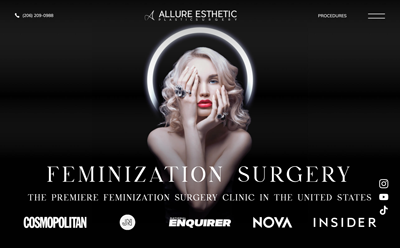Dr. Sajan can place breast implants through incisions in a few different locations. Depending on the patient’s goals and preferences, Dr. Sajan can help determine the right breast augmentation incision for each patient
Inframammary
The inframammary fold incision is the most commonly used breast augmentation incision. Made within the natural breast crease, the incision is usually around three to four centimeters. This incision offers Dr. Sajan full access to the breast tissues and pectoral muscle. It has the best visibility of all breast incision types.
The incision is generally not visible when wearing a bra. Often, the augmented breasts also help hide the incision. However, the inframammary incision is not always ideal for patients who want to keep scarring totally off the breasts.
Periareolar
The periareolar incision uses a half moon shaped incision that curves around the areola. The incision blends in with pigment change from the skin to the areola. It also allows for precise placement of the implant and may be preferred when placing implants above the muscle. The periareolar incision has many benefits. However, it is not widely used. This is because it carries the highest risk of damaging the milk ducts or disrupting nipple sensation in the long run.
If another procedure involving an incision near or around the areola is performed, such as a donut breast lift, then the periareolar incision may be recommended. Also, if a patient has no plans to breastfeed and does not care about nipple sensation, this is a potential option.
Transaxillary
The transaxillary breast augmentation method uses a small incision in the underarm to place the implant. This is becoming a popular technique because it keeps incisions away from the breasts and underarm incisions tend to heal discreetly. There is less visibility, but for an experienced plastic surgeon, this procedure is fairly routine.
There are not many major drawbacks. However, based on the size of the patient’s underarm and the size of the implant, this may pose issues. While it is possible to place silicone implants through the underarm, the implant must also be able to fit through the incision. Therefore, an 800cc silicone implant will likely not work through a transaxillary incision for a very petite woman. With that said, the average sized implant can almost always go through a transaxillary incision.
Transumbilical
Transumbilical breast augmentation is a newer method. It is not commonly performed because it can only accommodate saline implants. This technique does offer the most discreet scar—hidden within the belly button—of all breast augmentation surgeries. Many patients will not be candidates for a transumbilical incision because choosing silicone implants immediately eliminates this option.
Dr. Sajan has extensive experience with transumbilical breast augmentation and can evaluate if a patient can safely undergo the procedure. Though, he will also discuss the alternatives and help the patient make an informed decision.
Fat Transfer
Fat transfer to the breasts does not use a breast implant. Instead, it uses fat removed from the patient’s body via liposuction to augment the breasts. This has many upsides like looking and feeling natural, addressing specific concerns (such as biopsy scars), and enhancing other areas of the body with lipo.
If a patient wants a dramatic increase in breast size, they are likely to benefit more from breast implants. Fat transfer breast augmentation can usually increase breast size by one or two cups. For a more subtle augmentation, this is a good option. Dr. Sajan specializes in fat transfer to the breasts. He is one of the best for this procedure in Washington State.
 FeminizationSurgeries.com
FeminizationSurgeries.com

